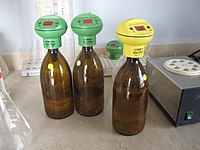
Photo from wikipedia
This study was conducted to investigate the nitrification of wastewater using polyvinyl alcohol (PVA) media immobilized with nitrifying bacteria. The microorganism‐immobilized media used in this study was prepared by mixing… Click to show full abstract
This study was conducted to investigate the nitrification of wastewater using polyvinyl alcohol (PVA) media immobilized with nitrifying bacteria. The microorganism‐immobilized media used in this study was prepared by mixing 10% (v/v) PVA, 6% (v/v) polyethylene glycol (PEG) and nitrifying microorganism culture solution. Analysis revealed that the nitrification rate when using the microorganism‐immobilized media increased to 49.1, 80.0 and 83.9% as the filling rate increased to 5, 15 and 25%, respectively. The mass transfer rate of the prepared microorganism‐immobilized media was estimated to be 37.69 mg/L·h maximum. The respiration rate was measured in order to compare with the microorganism‐immobilized media and the conventional biological treatment process of anaerobic‐anoxic‐oxic (A₂O). Respiration time of sludge and the media were similar, but the respiration rate of the microorganism‐immobilized media (initial 20.8 mg O₂/(L·h)) was higher than that of the activated sludge (initial 12.4 mg O₂/(L·h)).
Journal Title: Water and Environment Journal
Year Published: 2019
Link to full text (if available)
Share on Social Media: Sign Up to like & get
recommendations!